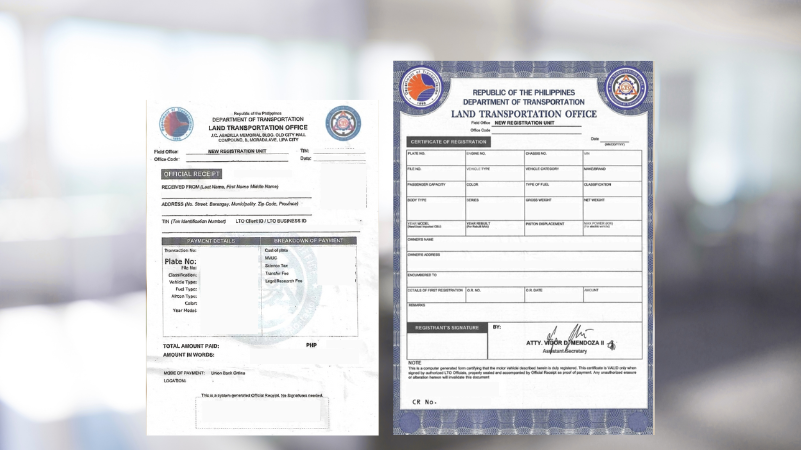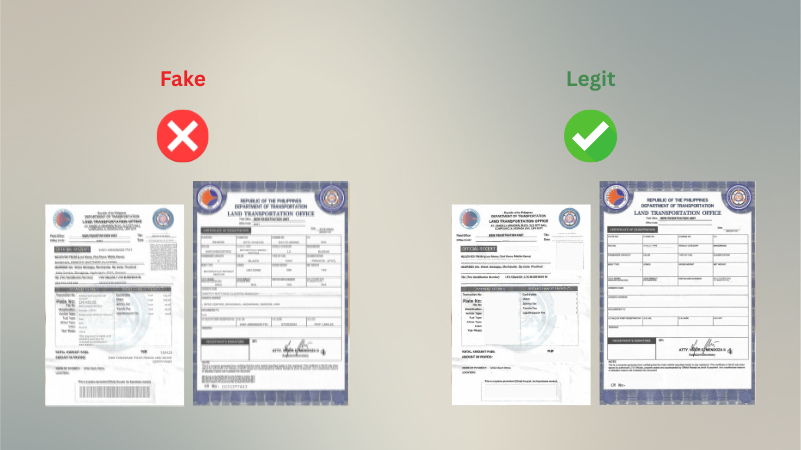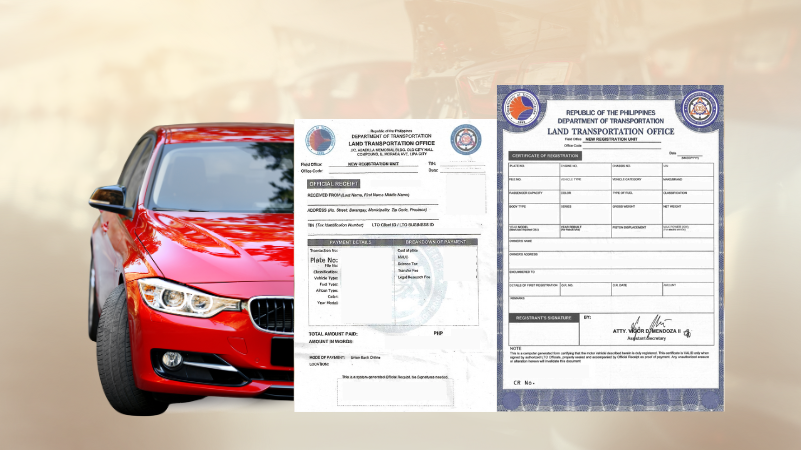Driving in the Philippines comes with its share of responsibilities. Beyond following traffic laws and ensuring your vehicle is roadworthy, having the proper documentation is essential. Among the critical documents every Filipino driver must have are the Official Receipt (OR) and Certificate of Registration (CR). These documents, collectively known as OR/CR, are proof that your vehicle is legally registered and ready to hit the road.
In this blog post, we’ll explore the importance of the OR/CR, what it entails, and why it’s indispensable for every motorist in the Philippines.
OR/CR Meaning in the Philippines
When you hear car dealers, traffic enforcers, or even online car sellers talk about “OR/CR” (or just “ORCR”), they’re referring to two of the most important papers every car owner in the Philippines must have.
Put simply:
- OR (Official Receipt) = proof that you paid your vehicle registration fees to the LTO
- CR (Certificate of Registration) = proof that your vehicle is registered and officially recognized by the government
Together, they serve as your vehicle’s legal “ID.” Without them, you can’t legally drive, sell, or even process car-related transactions.
What is OR (Official Receipt)?
The Official Receipt (OR) is the paper you get from the Land Transportation Office (LTO) after paying your vehicle’s registration fees, road user’s tax, and other charges.
In simple terms: Think of the OR as the “resibo” you get from LTO. Just like when you buy something from a store and get a receipt, the OR shows that you’ve settled your dues to legally keep your car on the road.
What the OR usually shows:
|
Category |
Details Included |
|
Vehicle Details |
– Plate Number or Temporary Plate Number – Make/Brand (e.g., Toyota, Honda) – Model and Year of Manufacture – Engine Number – Chassis Number – Color – Classification (e.g., Private, For Hire, Government) |
|
Owner Information |
– Registered Owner’s Name – Address |
|
Transaction Details |
– Transaction Type (e.g., New Registration, Renewal) – Date of Payment – OR Number (Unique Identifier) – Amount Paid with Breakdown: – Registration Fee – MVUC (Motor Vehicle User’s Charge) – Emission Test Fee – TPL (Third-Party Liability) Insurance Fee – Other charges (e.g., penalties) |
|
Validity Details |
– Registration Validity Period (e.g., valid until the same month next year) |
|
Authorized Signatures |
– Signature of the LTO cashier or authorized representative |
|
QR Code (if applicable) |
– May include a QR code for verification purposes, depending on 2024 updates |
Imagine being stopped at a traffic checkpoint. A traffic enforcer asks for your OR. Showing it proves that your registration payment is up to date — so you won’t get fined for expired registration.
What is CR (Certificate of Registration)?
The Certificate of Registration (CR) is the LTO-issued document that contains your vehicle’s technical and ownership details.
In simple terms: The CR is like your vehicle’s “birth certificate + ID card” combined. It officially records what your car is, and who owns it.
What the CR usually shows:
|
Category |
Details |
|
Vehicle Information |
|
|
Plate Number |
Unique alphanumeric code assigned to the vehicle. |
|
Vehicle Make and Model |
Manufacturer and specific model of the vehicle. |
|
Year Model |
The production year of the vehicle. |
|
Body Type |
Classification of the vehicle (e.g., sedan, SUV, motorcycle). |
|
Engine Number |
Unique identifier for the vehicle’s engine. |
|
Chassis Number |
Unique number assigned to the vehicle’s chassis or frame. |
|
Fuel Type |
Type of fuel the vehicle uses (e.g., gasoline, diesel, electric). |
|
Gross Weight |
Total weight of the vehicle, including cargo and passengers. |
|
Denomination |
The purpose or usage type of the vehicle (e.g., private, utility). |
|
Piston Displacement |
The engine’s capacity in cubic centimeters (cc). |
|
Number of Cylinders |
The total number of cylinders in the vehicle’s engine. |
|
Series |
Specific series or variant of the vehicle model. |
|
Body Number |
The identification number specific to the vehicle’s body. |
|
Net Weight |
The weight of the vehicle excluding passengers and cargo. |
|
Shipping Weight |
The weight of the vehicle as shipped from the manufacturer. |
|
Net Capacity |
The vehicle’s maximum load capacity, including passengers and cargo. |
|
Ownership Details |
|
|
Registered Owner |
Name of the individual or entity that owns the vehicle. |
|
Address |
Registered address of the owner. |
|
Telephone No./Contact Details |
Owner’s contact number or other details for communication. |
|
Encumbered To |
Financial institution or entity holding a lien on the vehicle. |
|
Registration Details |
|
|
Date of Registration |
Exact date the vehicle was registered. |
|
Expiration Date |
Validity period of the registration (annual renewal required). |
|
Official Receipt (OR) Number |
Reference number for the payment made during registration. |
|
OR Date |
Date of issuance of the official receipt for registration payment. |
|
Amount |
Total cost paid for the vehicle’s registration. |
|
Other Details |
|
|
Classification |
Vehicle’s usage category (e.g., private, commercial, government). |
|
MV File Number |
Motor vehicle file number used for record tracking. |
|
Color |
Official color of the vehicle as declared during registration. |
When selling your car, buyers will always ask for the CR because it shows that the car is officially registered and legally under your name. No CR? Most buyers won’t touch the deal because it raises questions about ownership and legality.
Difference Between OR and CR
You’ll often hear people say “may OR/CR ka ba?” at checkpoints, or even online marketplaces. That’s because these two documents always go hand in hand.
Why? Because OR and CR serve different but equally important purposes. The OR shows you’ve paid for registration, while the CR shows your car is officially registered under your name. That’s why they’re always paired together as “OR/CR” or “ORCR.”
Here’s a quick side-by-side look at the OR vs CR differences 👇
|
Feature |
OR (Official Receipt) |
CR (Certificate of Registration) |
|
Issuer |
LTO |
LTO |
|
Purpose |
Proof of payment |
Proof of registration & ownership |
|
Details Included |
Date of payment, amount, receipt number, fees paid |
Vehicle details (make, model, engine no., chassis no.), owner’s info |
|
Usage Scenarios |
Renewal confirmation, LTO checkpoints |
Car ownership transfer, financing, insurance claims |
|
Proves Ownership? |
❌ No — it only shows payment |
✅ Yes — recognized as proof of ownership |
Quick Example
- At an LTO checkpoint, enforcers will usually check your OR to confirm that your registration fees are up-to-date.
- When selling your car or applying for car insurance, the CR is more important since it confirms the vehicle’s official identity and ownership.
In short, the OR is like your payment receipt, while the CR is your car’s legal ID card. Both are necessary to keep your car on the road without hassle.
Why OR and CR are Important in the Philippines
For first-time car owners, it might feel like OR and CR are “just more paperwork” you need to keep in your glove compartment. But in reality, these two documents play a huge role in proving your car’s legitimacy, ownership, and compliance with the law. Let’s break down the most common situations where having your OR and CR ready is a must:
1. Traffic Checkpoints
If you’ve ever been stopped at an MMDA or LTO checkpoint, you already know the drill: the officer usually asks for your driver’s license and OR/CR.
- OR proves that your vehicle registration fees are paid.
- CR shows that your car is legally registered and under your name (or another legal owner).
Without these documents, you risk fines, penalties, or even your car being impounded.
2. Car Buying & Selling
Thinking of buying or selling a car? The difference between OR vs CR becomes even more important here.
- Sellers must present a valid OR/CR to prove that the vehicle isn’t stolen, unregistered, or carrying unpaid fees.
- Buyers should always check these documents before finalizing a deal.
In fact, many online listings highlight “ORCR complete” or “Original OR/CR” because it’s a sign that the vehicle is legit and transferable.
3. Vehicle Financing / ORCR Sangla
Another common use for ORCR in the Philippines is “ORCR sangla”—when car owners use their OR/CR as collateral for a loan.
- Lenders require the OR/CR as proof that the vehicle exists and is officially registered.
- Without them, your car can’t be accepted for financing.
Think of it as pawning your jewelry—only this time, it’s your car papers that secure the loan.
4. Insurance Claims
In case of an accident, your insurance provider will almost always ask for your OR and CR as part of the claim process.
- OR proves your vehicle registration is up to date.
- CR confirms ownership and vehicle details (like plate number, engine number, etc.).
Without them, processing your insurance claim could be delayed—or worse, denied.
5. Online Marketplaces
If you’ve browsed Facebook Marketplace, Carousell, or other car-buying platforms, you’ve probably seen the phrase: “Original ORCR” or “OR/CR Complete”
This simple phrase is a green flag for buyers because it guarantees the car’s papers are intact, which makes transfer of ownership much easier.
- A car without OR/CR is a red flag and might even indicate stolen property.
- Serious buyers often skip listings that don’t show proof of ORCR.
How to Get Your OR and CR in the Philippines

First Registration (Brand New Car)
When you purchase a brand-new car, you usually don’t have to worry about the initial registration.
- Car dealers handle the process with the LTO (Land Transportation Office) on your behalf.
- After filing and payment, the OR/CR are issued under your name.
- Timeline: It often takes a few weeks before your ORCR are released, so keep in touch with your dealer for updates.
Think of this as the dealer “processing the birth certificate” of your new car—you just need to wait for the official papers.
Renewal of Registration (Yearly)
For brand-new cars, many dealers now offer a free initial registration that covers three years. This means you don’t have to worry about renewing your vehicle registration after just one year. Instead, your first renewal will only be due starting on the fourth year of ownership.
After that, your registration must be renewed annually. Here’s how the renewal process usually goes:
- Emission Test – Your car must pass the smoke emission test.
- Insurance (CTPL) – Get Compulsory Third Party Liability (CTPL) insurance, which is required by law.
- LTO Payment – Head to the LTO and pay your renewal fees.
- Receive New OR – You’ll be given a new Official Receipt (OR) as proof of renewal.
Important: The Certificate of Registration (CR) remains the same unless there’s a transfer of ownership.
Online Registration (LTO Portal)
The LTO has been rolling out online services to make things more convenient.
- You can now process some parts of your renewal through the LTO Portal (LTMS).
- In some cases, you may be able to access a digital copy of your OR.
- However, your CR remains a physical document—you’ll need the original copy for ownership, transfers, and most transactions.
Tip: Always double-check if your LTO branch supports online services to save time
For a more detailed walkthrough, check out our guide here: How to Renew OR/CR in the Philippines: A Step-by-Step Guide
What to Do if You Lose Your ORCR
Losing your OR or CR can be stressful, especially since they’re among the most important car documents you’ll ever own. But don’t panic—there’s a proper process to replace them. Here’s what you need to know:
Lost OR (Official Receipt)
If you misplace your Official Receipt, here’s the step-by-step process to get a duplicate:
- Prepare an Affidavit of Loss – Have it notarized to certify that you indeed lost the document.
- Go to the LTO branch where the OR was originally issued.
- Request for a duplicate OR – You’ll need to present your affidavit and valid IDs.
- Pay the necessary fees for processing.
Reminder: While losing your OR is inconvenient, it’s easier to replace compared to the CR.
Lost CR (Certificate of Registration)
Now this one’s more serious. Since the CR proves vehicle ownership, losing it can cause problems when selling, transferring, or renewing your registration.
Steps to replace a lost CR:
- Prepare an Affidavit of Loss – Just like with the OR, this needs to be notarized.
- Secure an LTO Clearance – This confirms your vehicle’s records are legitimate and not flagged for any violations.
- Pay the required fees – Fees may vary depending on the LTO branch.
- Request for a replacement CR – Submit your documents, wait for processing, and claim your new CR.
Tip: Always keep multiple photocopies of your ORCR. Use the photocopies when driving daily (especially for checkpoints), and store the original documents safely at home—ideally in a waterproof folder or fireproof box.
How to Check the Authenticity of OR and CR
If you’re buying a second-hand car, one of the biggest risks is ending up with fake OR/CR documents. Sadly, this is more common than many realize, which is why knowing how to spot authentic papers is a must.
Here’s a quick step-by-step guide to help you verify if an OR or CR is real:
- Check the security features
- Genuine ORCR documents are printed on special paper with security seals and watermarks.
- If the paper feels too thin or looks like it was just printed on regular bond paper, that’s a red flag.
- Cross-check the details
- Compare the plate number, engine number, and chassis number on the CR with what’s physically on the car.
- Even small mismatches should be taken seriously—they may signal tampering.
- Verify directly with the LTO
- The safest way is to visit the Land Transportation Office (LTO) and request verification.
- Some branches may even assist with online inquiries if you provide the vehicle details.
If someone’s selling you a car at a suspiciously low price but refuses to let you verify the OR/CR at the LTO, that’s a clear warning sign—better walk away.
ORCR in Financing and Insurance
Now that you know how to spot a genuine OR and CR, let’s talk about why they’re important in financial transactions like loans and insurance.
ORCR Sangla in the Philippines
One common term you’ll hear in the Philippines is “ORCR sangla.”
- This simply means using your OR/CR as collateral for a loan.
- It’s popular in lending and pawn setups, especially for people who need quick cash.
- Lenders hold the ORCR as security until the borrower repays the loan.
⚠️ If you fail to pay back the loan, the lender may legally claim ownership of your vehicle since the ORCR documents are under their custody.
Let’s say you urgently need ₱50,000. A small financing company might offer you the loan if you surrender your ORCR. But if you miss payments, you could lose your car entirely.
Insurance Purposes
Insurance companies also always ask for your OR and CR when you apply for coverage or make a claim.
- The OR proves your car is legally registered with the LTO.
- The CR shows that the vehicle is really under your name (or your company’s).
Without these documents, insurance companies can’t process your application—or worse, they may reject your claim after an accident.
If your car gets into an accident and you don’t have the CR under your name, your insurance company might deny your claim because technically, you’re not the registered owner.
Whether it’s buying a used car, applying for a loan, or filing an insurance claim, your OR/CR aren’t just papers—they’re proof of your vehicle’s legality, ownership, and value.
Common FAQs About OR and CR
Even after understanding the difference between OR and CR, many first-time car owners still have questions. Let’s answer some of the most common ones:
Does OR prove ownership?
❌ No. The Official Receipt (OR) only proves you paid for registration.
✅ Only the Certificate of Registration (CR) proves legal ownership of the vehicle.
Shortcut to remember: OR = payment, CR = ownership.
Can I drive without OR/CR?
❌ No. If you’re caught at an MMDA or LTO checkpoint without your OR/CR, you risk:
- Fines for failure to carry vehicle documents.
- Possible impoundment of your vehicle if ownership can’t be verified.
Tip: Bring photocopies of your OR and CR for daily driving, and keep the originals in a safe place at home.
How much is the penalty for not carrying ORCR?
The penalty may vary depending on the LTO’s rules, but in general:
- ₱1,000 fine for failure to carry your OR and CR.
- If there’s suspicion of fake documents, you may also face impoundment until verification.
Better safe than sorry—always have at least a photocopy in your glove compartment.
Can OR/CR be digital?
- OR (Official Receipt): Some branches of LTO allow you to access a digital OR via the LTMS (Land Transportation Management System) portal.
- CR (Certificate of Registration): This is still strictly a physical document. You need the original hard copy for ownership, transfer, and insurance.
Final Thoughts
The ORCR means much more than just paperwork—it’s your passport to safe and hassle-free driving in the Philippines. By keeping your documents up to date and readily available, you minimize legal risks and protect yourself financially.
Here’s a quick recap to make things easier:
- Always keep the original OR and CR safe at home. Carry photocopies for checkpoints and everyday driving.
- Don’t buy a second-hand car without verifying the CR with the LTO. If the CR doesn’t match the vehicle, walk away.
- Shortcut reminder:
- OR = payment proof
- CR = ownership proof
Stay compliant, drive smart, and enjoy peace of mind every time you hit the road! 🚗💨







